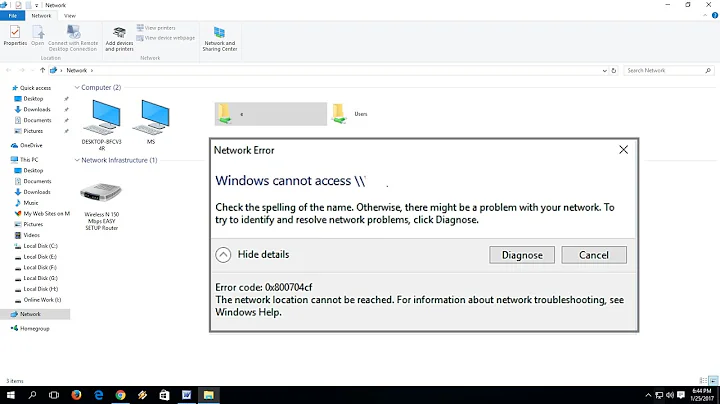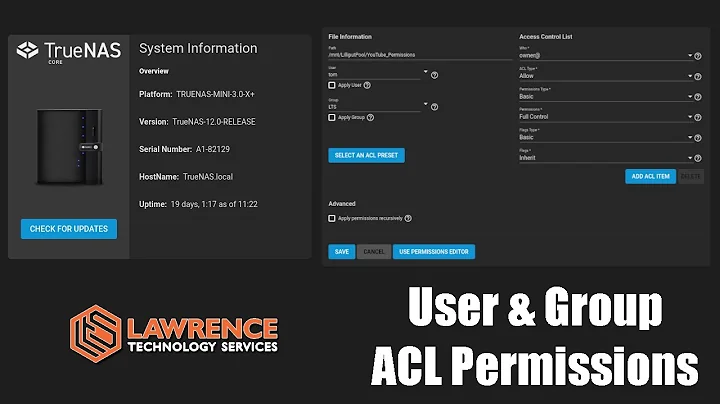Windows users can see my samba shares and list folders but can't access them
By the time one removes all the comment lines (those starting with # or ;) there's very little left. In particular there are no shares.
sed -e 's/^\s*//' -e '/^[#;]/d' -e '/^$/d' /etc/samba/smb.conf
[global]
usershare path = /var/lib/samba/usershares
usershare max shares = 100
usershare allow guests = yes
usershare owner only = yes
workgroup = WORKGROUP
netbios name = necrostation
server string = Samba Server
map to guest = Bad User
printcap name = /dev/null
load printers = No
disable spoolss = Yes
printing = bsd
log file = /var/log/samba/%m.log
max log size = 50
security = user
name resolve order = wins lmhosts host bcast
wins support = yes
dns proxy = no
You probably want to uncomment one of the commented blocks and create the directory (mkdir -m777 /home/samba):
[public]
comment = Public stuff
path = /home/samba
public = yes
read only = no
Related videos on Youtube
roaima
International IT Director for Mission Without Borders, an international Christian charity helping families and children in six of the poorest countries in Eastern Europe: Albania, Bosnia and Herzegovina, Bulgaria, Moldova, Romania, and Ukraine. Longtime Unix/Linux user (first used 1984, professional since 1988). Enjoying a bit of a change with Windows (professional, on and off, since 1988). Know which I prefer. Ad hoc consulting enquiries welcome by email to info @ roaima.co.uk. (I try to reply to everyone. Please check your spam folder for replies as Gmail really doesn't like me.) Feel free to buy me a coffee should you want to do so. I can particularly recommend Machu Picchu from Café Direct if you'd like to try something yourself. Or you can donate to Mission Without Borders and help our ongoing work in Ukraine and Eastern Europe. Have you tried the English tradition of bell ringing? You can read a story or a poem about it, or even watch a video if you prefer.
Updated on September 18, 2022Comments
-
 roaima over 1 year
roaima over 1 yearI configured Samba (Arch Linux 64 bit) to use usershares and I wanted to share some folders with my Windows 10 laptop. I can see my Arch computer on Windows, access it, list folders but I can't access them (Windows shows popup that can't access my shared folder). It also does not work for shares specified in
smb.conf.Here is my
smb.conffile:# This is the main Samba configuration file. You should read the # smb.conf(5) manual page in order to understand the options listed # here. Samba has a huge number of configurable options (perhaps too # many!) most of which are not shown in this example # # Any line which starts with a ; (semi-colon) or a # (hash) # is a comment and is ignored. In this example we will use a # # for commentry and a ; for parts of the config file that you # may wish to enable # # NOTE: Whenever you modify this file you should run the command "testparm" # to check that you have not made any basic syntactic errors. # #======================= Global Settings ===================================== [global] usershare path = /var/lib/samba/usershares usershare max shares = 100 usershare allow guests = yes usershare owner only = yes # workgroup = NT-Domain-Name or Workgroup-Name workgroup = WORKGROUP netbios name = necrostation # server string is the equivalent of the NT Description field server string = Samba Server map to guest = Bad User # This option is important for security. It allows you to restrict # connections to machines which are on your local network. The # following example restricts access to two C class networks and # the "loopback" interface. For more examples of the syntax see # the smb.conf man page ; hosts allow = 192.168.1. 192.168.2. 127. # if you want to automatically load your printer list rather # than setting them up individually then you'll need this printcap name = /dev/null load printers = No disable spoolss = Yes # It should not be necessary to spell out the print system type unless # yours is non-standard. Currently supported print systems include: # bsd, sysv, plp, lprng, aix, hpux, qnx printing = bsd # Uncomment this if you want a guest account, you must add this to /etc/passwd # otherwise the user "nobody" is used ; guest account = pcguest # this tells Samba to use a separate log file for each machine # that connects log file = /var/log/samba/%m.log # Put a capping on the size of the log files (in Kb). max log size = 50 # Security mode. Most people will want user level security. See # security_level.txt for details. security = user # Use password server option only with security = server ; password server = <NT-Server-Name> # Password Level allows matching of _n_ characters of the password for # all combinations of upper and lower case. ; username level = 8 # You may wish to use password encryption. Please read # ENCRYPTION.txt, Win95.txt and WinNT.txt in the Samba documentation. # Do not enable this option unless you have read those documents ; encrypt passwords = yes ; smb passwd file = /etc/samba/smbpasswd # The following are needed to allow password changing from Windows to # update the Linux sytsem password also. # NOTE: Use these with 'encrypt passwords' and 'smb passwd file' above. # NOTE2: You do NOT need these to allow workstations to change only # the encrypted SMB passwords. They allow the Unix password # to be kept in sync with the SMB password. ; unix password sync = Yes ; passwd program = /usr/bin/passwd %u ; passwd chat = *New*UNIX*password* %n\n *ReType*new*UNIX*password* %n\n *passwd:*all*authentication*tokens*updated*successfully* # Unix users can map to different SMB User names ; username map = /etc/samba/smbusers # Using the following line enables you to customise your configuration # on a per machine basis. The %m gets replaced with the netbios name # of the machine that is connecting ; include = /etc/samba/smb.conf.%m # Configure Samba to use multiple interfaces # If you have multiple network interfaces then you must list them # here. See the man page for details. ; interfaces = 192.168.12.2/24 192.168.13.2/24 # Configure remote browse list synchronisation here # request announcement to, or browse list sync from: # a specific host or from / to a whole subnet (see below) ; remote browse sync = 192.168.3.25 192.168.5.255 # Cause this host to announce itself to local subnets here ; remote announce = 192.168.1.255 192.168.2.44 # Browser Control Options: # set local master to no if you don't want Samba to become a master # browser on your network. Otherwise the normal election rules apply ; local master = no # OS Level determines the precedence of this server in master browser # elections. The default value should be reasonable ; os level = 33 # Domain Master specifies Samba to be the Domain Master Browser. This # allows Samba to collate browse lists between subnets. Don't use this # if you already have a Windows NT domain controller doing this job ; domain master = yes # Preferred Master causes Samba to force a local browser election on startup # and gives it a slightly higher chance of winning the election ; preferred master = yes # Use only if you have an NT server on your network that has been # configured at install time to be a primary domain controller. ; domain controller = <NT-Domain-Controller-SMBName> # Enable this if you want Samba to be a domain logon server for # Windows95 workstations. ; domain logons = yes # if you enable domain logons then you may want a per-machine or # per user logon script # run a specific logon batch file per workstation (machine) ; logon script = %m.bat # run a specific logon batch file per username ; logon script = %U.bat # Where to store roving profiles (only for Win95 and WinNT) # %L substitutes for this servers netbios name, %U is username # You must uncomment the [Profiles] share below ; logon path = \\%L\Profiles\%U # All NetBIOS names must be resolved to IP Addresses # 'Name Resolve Order' allows the named resolution mechanism to be specified # the default order is "host lmhosts wins bcast". "host" means use the unix # system gethostbyname() function call that will use either /etc/hosts OR # DNS or NIS depending on the settings of /etc/host.config, /etc/nsswitch.conf # and the /etc/resolv.conf file. "host" therefore is system configuration # dependant. This parameter is most often of use to prevent DNS lookups # in order to resolve NetBIOS names to IP Addresses. Use with care! # The example below excludes use of name resolution for machines that are NOT # on the local network segment # - OR - are not deliberately to be known via lmhosts or via WINS. name resolve order = wins lmhosts host bcast # Windows Internet Name Serving Support Section: # WINS Support - Tells the NMBD component of Samba to enable it's WINS Server wins support = yes # WINS Server - Tells the NMBD components of Samba to be a WINS Client # Note: Samba can be either a WINS Server, or a WINS Client, but NOT both ; wins server = w.x.y.z # WINS Proxy - Tells Samba to answer name resolution queries on # behalf of a non WINS capable client, for this to work there must be # at least one WINS Server on the network. The default is NO. ; wins proxy = yes # DNS Proxy - tells Samba whether or not to try to resolve NetBIOS names # via DNS nslookups. The built-in default for versions 1.9.17 is yes, # this has been changed in version 1.9.18 to no. dns proxy = no # Case Preservation can be handy - system default is _no_ # NOTE: These can be set on a per share basis ; preserve case = no ; short preserve case = no # Default case is normally upper case for all DOS files ; default case = lower # Be very careful with case sensitivity - it can break things! ; case sensitive = no #============================ Share Definitions ============================== ;[homes] ;comment = Home Directories ;browseable = no ;writable = yes # Un-comment the following and create the netlogon directory for Domain Logons ; [netlogon] ; comment = Network Logon Service ; path = /home/netlogon ; guest ok = yes ; writable = no ; share modes = no # Un-comment the following to provide a specific roving profile share # the default is to use the user's home directory ;[Profiles] ; path = /home/profiles ; browseable = no ; guest ok = yes # NOTE: If you have a BSD-style print system there is no need to # specifically define each individual printer ;[printers] ;comment = All Printers ;path = /var/spool/samba ;browseable = no # Set public = yes to allow user 'guest account' to print ;guest ok = no ;writable = no ;printable = yes # This one is useful for people to share files ;[tmp] ; comment = Temporary file space ; path = /tmp ; read only = no ; public = yes # A publicly accessible directory, but read only, except for people in # the "staff" group ;[public] ; comment = Public Stuff ; path = /home/samba ; public = yes ; read only = yes ; write list = @staff # Other examples. # # A private printer, usable only by fred. Spool data will be placed in fred's # home directory. Note that fred must have write access to the spool directory, # wherever it is. ;[fredsprn] ; comment = Fred's Printer ; valid users = fred ; path = /homes/fred ; printer = freds_printer ; public = no ; writable = no ; printable = yes # A private directory, usable only by fred. Note that fred requires write # access to the directory. ;[fredsdir] ; comment = Fred's Service ; path = /usr/somewhere/private ; valid users = fred ; public = no ; writable = yes ; printable = no # a service which has a different directory for each machine that connects # this allows you to tailor configurations to incoming machines. You could # also use the %u option to tailor it by user name. # The %m gets replaced with the machine name that is connecting. ;[pchome] ; comment = PC Directories ; path = /usr/pc/%m ; public = no ; writable = yes # A publicly accessible directory, read/write to all users. Note that all files # created in the directory by users will be owned by the default user, so # any user with access can delete any other user's files. Obviously this # directory must be writable by the default user. Another user could of course # be specified, in which case all files would be owned by that user instead. ;[public] ; path = /usr/somewhere/else/public ; public = yes ; only guest = yes ; writable = yes ; printable = no # The following two entries demonstrate how to share a directory so that two # users can place files there that will be owned by the specific users. In this # setup, the directory should be writable by both users and should have the # sticky bit set on it to prevent abuse. Obviously this could be extended to # as many users as required. ;[myshare] ; comment = Mary's and Fred's stuff ; path = /usr/somewhere/shared ; valid users = mary fred ; public = no ; writable = yes ; printable = no ; create mask = 0765 -
 guntbert almost 7 yearsWhat is the rationale behind 777?
guntbert almost 7 yearsWhat is the rationale behind 777? -
 roaima almost 7 years@guntbert Samba handles permissions and access control. Mixing UNIX/Linux semantics and Samba's permissions is wrong so it's best to disable the UNIX/Linux permissions. (There are VFS options that overload the UNIX/Linux permissions, but they aren't shown in this
roaima almost 7 years@guntbert Samba handles permissions and access control. Mixing UNIX/Linux semantics and Samba's permissions is wrong so it's best to disable the UNIX/Linux permissions. (There are VFS options that overload the UNIX/Linux permissions, but they aren't shown in thissmb.confso the OP probably doesn't need or want those.) -
 guntbert almost 7 yearsThx for the explanation, now I see the reason for problems I have encountered.
guntbert almost 7 yearsThx for the explanation, now I see the reason for problems I have encountered.




